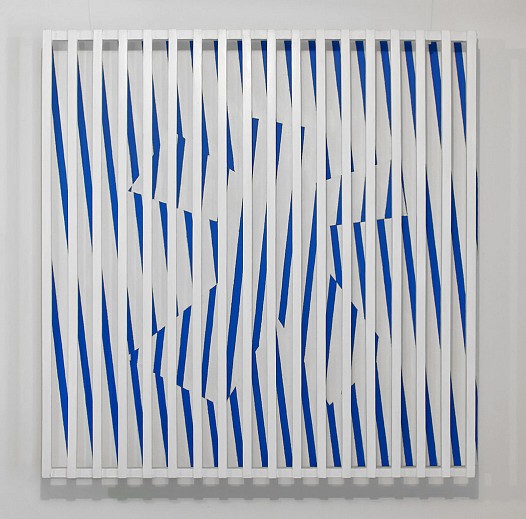
Points of Engagement
February 6, 2020 - D. Dominick Lombardi for Dart International Magazine
The success of an exhibition, or any work of art for that matter, is its ability to engage the viewer. Engagement can be a bit more difficult to achieve when you eliminate any sort of representation, as with the current exhibition at the Hofstra Museum of Art, Uncharted: American Abstraction in the Information Age. The fact that this show truly connects with the viewer – in this instance, partly through the use and influence of technology – illustrates the more thought provoking side of abstract art. Organized by Karen T. Albert, Acting Director and Chief Curator, with essays by Laurie Fendrich and Creighton Michael, Uncharted quickly draws you in through a variety of means that include everything from hi-tech contraptions to mesmerizing optics. When curiosity is piqued and perceptions are expanded, the viewer becomes part of the expression – a key difference between completely spelled out narrative representational art and non-representational abstraction. That unavoidable brain activity that is prompted by something new or visually foreign is very different than the comfort that straight representation brings.
Inspired by the spiral and alternating patterns commonly found in nature, Irene Rousseau offers two mixed media works form her Stretching the Space series. Here, we see how mathematics can reconstruct nature’s organic growth patterns resulting in images that look somewhere between Native American textiles and a computerized pinwheel. What I find most impressive about Rousseau’s art is the ever so subtle variations in the design suggesting human thought, even fallibility, which brings in the hint of chance.
Lynne Harlow’s installation, All Above the Moon (2020), literally invites museumgoers to physically enter the work. As a sight specific installation that occupies one corner of the exhibition space, All Above the Moon brings to mind those accidental voyeuristic moments when we catch ourselves looking through a sheer curtain into a private space. The fact that one can ‘enter’ the space gives this work a strange feeling: are we the viewer or the subject? On the other hand, the veil that partially obscures the two bands of turquoise fabrics that both mimic the arch of the front element and define the pre-existing corner of the room suggest that space between conscious thought and memory.
The ‘drawings’ of Daniel G. Hill are comprised solely of thin metal wire. When installed on a gallery wall, the position of each wire, as they are attached in various shapes and patterns, are subject to gravity. Since these works project slightly from the wall, shadows are created enhancing the overall visual experience. The loops at each end of the connected metal lengths act as dots, reminding this viewer of the ‘connect the dots’ game played as a child, while the spatial and perspective references bring to mind certain aspects of architecture and design.
Using masking tape, acrylic paint and shaped panels, Gilbert Hsiao dazzles the viewer with optical illusions that distort our perception. In Galaxie 64 (2015), there is a very distinct suggestion of how a black hole swallows up everything and anything in its path. In Slide (2012), the bottom of the form appears to bloat out and round off, similarly to the center of Galaxie 64, where the suggestion of bounce light seems to curve the plane. In both works the care and precision taken makes the whole thing look mechanical or machine made, while the forms and concepts seem otherworldly and far futuristic.Patricia Zarate’s two works comprised of hand-cut, colored paper mounted directly to the wall continues the pursuit of optical illusion; only here the results are a bit more understated. In using precisely shaped yellow, gray and black triangles, Zarate is able to create directional patterns that defy explanation. Upon closer inspection, the colors chosen and the way they are placed in bunches changes the perception of the white wall, creating variations of the white that you know are wrong but cannot correct in your brain. Reminiscent of ancient inlaid marble floor patterns that implied dimension, the artist combines past and present aesthetics to project her theories
The kinetic sculptures of James Seawright add a strong technological component to the exhibition. Using various sensors, Twins (1992) can be a bit sensitive to the movements in its immediate environment adding to its already palpable creepiness. Gemini (2004) and Lyra (2006) movements and lights are completely preprogrammed. As objects, they give the impression of designs for futuristic theater or movie sets. Despite the fact that all these works are between 14 and 28 years old, they maintain their immediacy and freshness. Like Lynne Harlow’s All Above the Moon, John Goodyear offers another aspect of physical participation for the viewer. By carefully swaying the picket fence-like apparatus in front of his two paintings, the art immediately becomes animated with short bursts of movement. Figurative Abstraction (2015) has an almost hypnotic effect on the viewer when it is activated – something like fabric billowing in the wind. The result with Diving Board (1983) is quite different. It shows a person’s feet continually being propelled by a very springy board, while offering much needed humor to the omnipresence of more elusive technology.
James O. Clark manages a most curious blend of art and science. Using colorful argon light tubes, Clark creates the strongest visceral effects in the show. Looking something like the entangled inner workings of a robot’s digestive tract, if they actually had one, Reflective Moments (2018) and Coruscate (2018) beautifully and softly color the space they occupy while compelling the viewer to peer into its source. A third piece, Tralfamadorian (2020), refers to the alternative and all-knowing world of Tralfamadore created by Kurt Vonnegut. The basic notion by physicists that time is a human construct and not ‘real’, plays right into this clever work by Clark. Up is down and down is up, a metaphor for the place where the past, present and future occur simultaneously. Link: https://www.hofstra.edu/community/museum/museum_exhibition_uncharted_american_abstraction.html
Back to News
